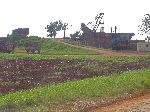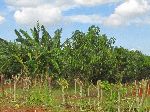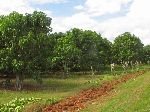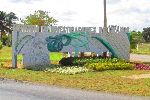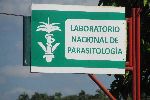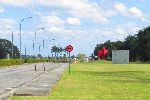| . | ||
Pinar
del Rio
|
||
Sugar |
||

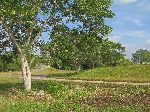
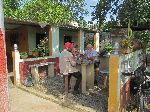
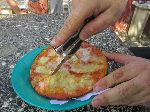 |
||
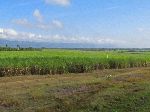 The cultivation of sugar cane was introduced in Cuba in the early 16th
century by Diego Velázquez, quickly leading Cuba to export to Spain.
After a significant reduction in exports in the following times, Cuba was
once again the leading exporter of sugar in the 19th century. Growing demand
from the international market and especially from the U.S. market pressured
Cuba to specialize in the cultivation of sugar cane. By the end of the 1950s
two-thirds of agriculture was in sugar cane and 80% of exports were sugar
and derivatives, with serious social consequences for workers.
Despite the preferential prices for Cuban sugar paid in the American market,
this situation led Cuba to an excessive dependence on the price and quota of
sugar in the unstable international market.
This economic weapon of importers was used by the US against Cuba in 1960.
After the revolution, diversification of agricultural production did not
succeed, and Cuba concentrates both its human and physical resources on
sugar production for new markets . An
agreement with the former Soviet Union helped Cuba, but planned production
could not be achieved and caused serious disruption to the country's economy
in general. The cultivation of sugar cane was introduced in Cuba in the early 16th
century by Diego Velázquez, quickly leading Cuba to export to Spain.
After a significant reduction in exports in the following times, Cuba was
once again the leading exporter of sugar in the 19th century. Growing demand
from the international market and especially from the U.S. market pressured
Cuba to specialize in the cultivation of sugar cane. By the end of the 1950s
two-thirds of agriculture was in sugar cane and 80% of exports were sugar
and derivatives, with serious social consequences for workers.
Despite the preferential prices for Cuban sugar paid in the American market,
this situation led Cuba to an excessive dependence on the price and quota of
sugar in the unstable international market.
This economic weapon of importers was used by the US against Cuba in 1960.
After the revolution, diversification of agricultural production did not
succeed, and Cuba concentrates both its human and physical resources on
sugar production for new markets . An
agreement with the former Soviet Union helped Cuba, but planned production
could not be achieved and caused serious disruption to the country's economy
in general. |
||
|
|
||
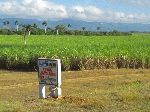
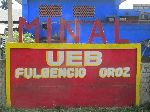
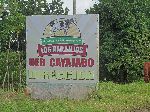
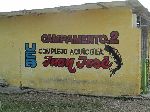
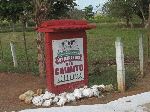 |
||
| We started seeing UEB (Unidades Empresariales de Base) signs back in Santa Lucia. There they were connected with mining and forestry. It took me more than a week of seeing them before I was motivated to start documenting the diversity. In this area, UEB has operations in cattle, poultry, sugar, rice, fruit, and almost every other agricultural commodity. In sort of the same way that ANAP is a cooperative for small producers, UEB is a conglomerate for industrial enterprises. But, based on published literature, ANAP may be more effective at what it is trying to do than UEB is at achieving its objectives -- capturing management expertise and efficiency, and transferring that to the success of if far flung components seems to be a challenge in Cuba. | ||
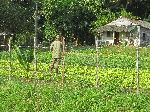 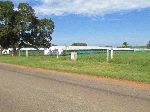 While a lot of the land in this area seems to be associated with UEB, not all of
the agriculture is corporate. Between some of the big farms are more traditional
looking homestead, mostly growing vegetables.
While a lot of the land in this area seems to be associated with UEB, not all of
the agriculture is corporate. Between some of the big farms are more traditional
looking homestead, mostly growing vegetables. |
||
|
|
||
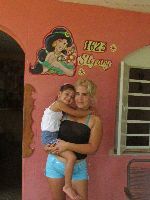  This
picture on the wall is labeled Stefany. Below the picture is Stefany, with
the big smile, and her mother, the artist. This
picture on the wall is labeled Stefany. Below the picture is Stefany, with
the big smile, and her mother, the artist.Rarely a group to pass up a fresh juice stand, we sampled (several glasses a person) what was being offered. Juice is sold in pesos, so it is usually only the equivalent of a few cents a glass. |
||
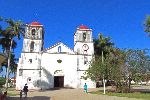
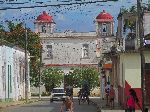
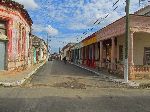
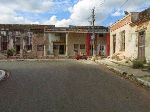
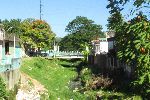 |
||
| There is nothing overtly touristy about San Antonio de los Banos. It may be this very fact which should earn it a place on the list of places that should be visited. There are a couple of stately, classic churches, neighborhood streets are typical of small-town-Cuba, and a river runs through it -- the town. | ||

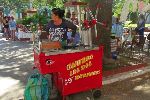
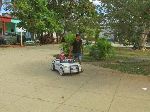
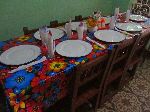
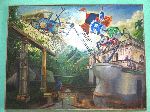 |
||
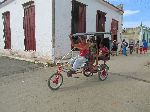 Around
town, the central plaza is active. For refreshment, there is shaved ice for
sell, and for amusement, kiddy cars are available. In a near-by restaurant there
is a surrealistic painting that seems to feature a broken scene and a lot of
things being sucked into a giant toilet. One can assume that it is expressing a
value statement. If you don't have your own bike, and need to get around town,
Pedi cabs are available to help you out. Around
town, the central plaza is active. For refreshment, there is shaved ice for
sell, and for amusement, kiddy cars are available. In a near-by restaurant there
is a surrealistic painting that seems to feature a broken scene and a lot of
things being sucked into a giant toilet. One can assume that it is expressing a
value statement. If you don't have your own bike, and need to get around town,
Pedi cabs are available to help you out. |
||
 San Antonio de los Banos
is noted for two institutions; the Escuela Internacional de Cine y TV (EICTV)
and the Museo del Humor: San Antonio de los Banos
is noted for two institutions; the Escuela Internacional de Cine y TV (EICTV)
and the Museo del Humor:EICTV was founded on December 15, 1986, by Colombian Colombian journalist, writer, and Nobel laureate Gabriel Garcia Marquez, Argentinean poet and film maker Fernando Birri (considered the father of the new Latin America cinema), and Cuban theoretician and film maker Julio Garcia Espinosa, amongst others, including Sergio Muniz, a Brazilian film maker. Each year around 40 students are selected from across Latin America, Africa, Asia and Europe to complete the school's Curso Regular (Regular Course). The Curso Regular is an intensive three year syllabus; each student specializes in one of the following disciplines: documentary, directing, edition, cinematography, sound, production, or screenwriting. The campus is in the flat farm fields 2 miles northwest of town. |
||
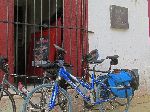
 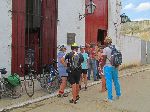 San Antonio de los Baños has a history of producing famous humorist and satirical publication. From this cam the Museo del Humor, the oldest of its kind in Cuba and Central and South America. Its archives include tens of thousands of pieces. |
||
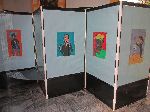 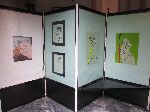 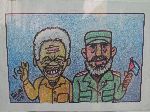 Exhibits
include paintings, sculptures, videos and caricatures. It hosts the International Biennial of Graphic Humour in
early April of odd number years, that includes all types of
presentations of humor. 2017 marks the twentieth biennial. Exhibits
include paintings, sculptures, videos and caricatures. It hosts the International Biennial of Graphic Humour in
early April of odd number years, that includes all types of
presentations of humor. 2017 marks the twentieth biennial. |
||
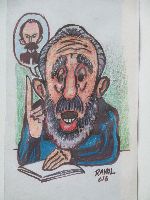
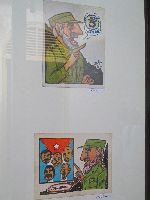
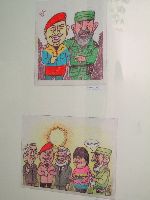
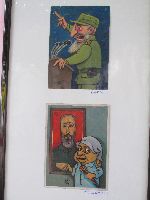
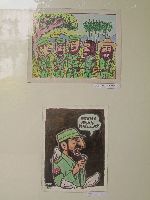
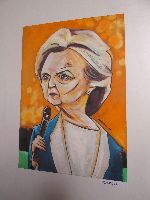
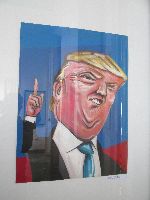 |
||
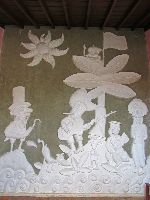 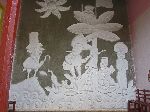 This
is a wall-size bas-relief reflecting some Cuban history. The United States
is represented by the character on the far left, with a peg-leg and a hook
for a hand. At the edge of the island, a dog is lifting his leg towards the
United States. The worker with the large hat, smoking a cigar and playing a
guitar, whose finger board turns into the barrel of a gun, is a
revolutionary. There is also a revolutionary perched in the top of the tree.
The two small figures, one wearing a dunce cap and the other, a pudgy fellow
with a bow tie, are carton characters from the early twentieth century who
were used to represent the establishment. The skinny person on the right is
a worker. This
is a wall-size bas-relief reflecting some Cuban history. The United States
is represented by the character on the far left, with a peg-leg and a hook
for a hand. At the edge of the island, a dog is lifting his leg towards the
United States. The worker with the large hat, smoking a cigar and playing a
guitar, whose finger board turns into the barrel of a gun, is a
revolutionary. There is also a revolutionary perched in the top of the tree.
The two small figures, one wearing a dunce cap and the other, a pudgy fellow
with a bow tie, are carton characters from the early twentieth century who
were used to represent the establishment. The skinny person on the right is
a worker. |
||
|
|
||
|
|
||
 Curiously,
for over a mile, in front of UCI, the normally two-lane, asphalt, San Pedro
road, becomes a six-lane, concrete-slab "highway". It is conspicuously similar
in engineering to a military landing strip - written accounts confirm that it
was used by transport aircraft to supply the Lourdes facilities. Curiously,
for over a mile, in front of UCI, the normally two-lane, asphalt, San Pedro
road, becomes a six-lane, concrete-slab "highway". It is conspicuously similar
in engineering to a military landing strip - written accounts confirm that it
was used by transport aircraft to supply the Lourdes facilities. |
||
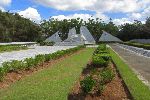

 Memorial
al Soldado Internacionalista Sovietico:
A low visibility monument, inaugurated on 23 February 1978, it contains the
remains of 67 Soviet military personnel who died in Cuba, mostly in 1962-64, and
mostly in August, September and October of each year. Most
were around age 22. These are the months of
the latter rainy season and likely to coincide with the malaria season. It has
only been since the 1970s that the Cuba health service worked to eradicate
malaria. [The mosquito is still present but the disease is rare now.]
Another piece of the story is that the mission to Cuba was so top secret that
personnel were not told were they were going. According to one memoir, they
didn't pack what could have been more appropriate kits for the tropical climate.
They didn't have appropriate equipment, clothes, food, medicine, vaccination,
etc. Memorial
al Soldado Internacionalista Sovietico:
A low visibility monument, inaugurated on 23 February 1978, it contains the
remains of 67 Soviet military personnel who died in Cuba, mostly in 1962-64, and
mostly in August, September and October of each year. Most
were around age 22. These are the months of
the latter rainy season and likely to coincide with the malaria season. It has
only been since the 1970s that the Cuba health service worked to eradicate
malaria. [The mosquito is still present but the disease is rare now.]
Another piece of the story is that the mission to Cuba was so top secret that
personnel were not told were they were going. According to one memoir, they
didn't pack what could have been more appropriate kits for the tropical climate.
They didn't have appropriate equipment, clothes, food, medicine, vaccination,
etc. There is an eternal flame and a time capsule at the center of the memorial. |
||
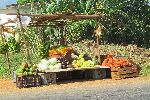 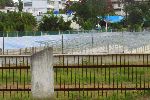 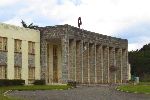  One
the outskirts of Havana there is a variety of land uses: fruit and vegetable
stands, a plot that is being developed for solar voltaic panels, a modern
building, get its final touches that looks like it is intended to be a showroom
for something, and an older building with a larger than life safety-pin stuck
through the eve. One
the outskirts of Havana there is a variety of land uses: fruit and vegetable
stands, a plot that is being developed for solar voltaic panels, a modern
building, get its final touches that looks like it is intended to be a showroom
for something, and an older building with a larger than life safety-pin stuck
through the eve. |
||
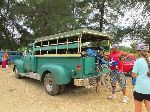 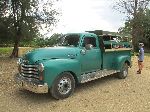 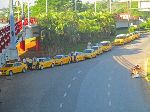 Finally,
a couple of parting pictures on transport. To the right is an old pick-up that
is set-up to carry people in the back, but this day was used for bicycles. And,
the line of yellow taxis at Jose Marti International Airport, Terminal 3,
waiting to carry arriving passengers into town. Finally,
a couple of parting pictures on transport. To the right is an old pick-up that
is set-up to carry people in the back, but this day was used for bicycles. And,
the line of yellow taxis at Jose Marti International Airport, Terminal 3,
waiting to carry arriving passengers into town. |
||
|
|
||
    |
||
|
"Hosted by
DreamHost - earth friendly web hosting"
|
||
|
|
|
